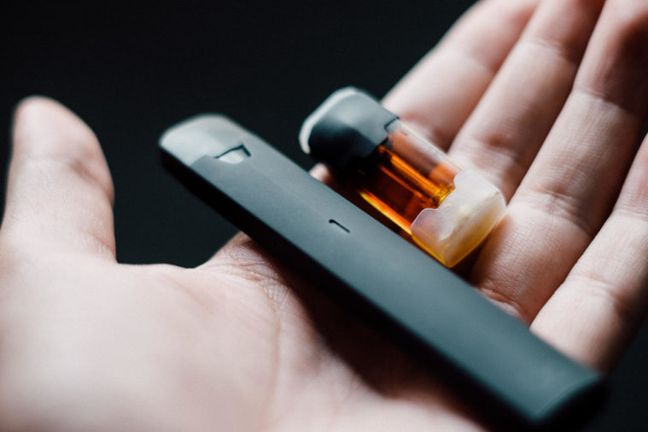The electronic cigarette, also known as an e-cigarette, allows people to enjoy the behavioral aspects of smoking, including the hand-to-mouth action of smoking with without burning tobacco. Using an e-cigarette is commonly known as “vaping.” When someone vapes, the battery-operated e-cigarette heats liquid into a vapor which can be inhaled. The vapor may contain nicotine (the addictive drug in tobacco), flavoring, and other chemicals. E-cigarettes can also be used with marijuana, hash oil, or other substances.
Vaping activity has risen considerably within the last several years. Particularly, vaping has surged in the past two years among teenagers and young adults. According to the federal centers for Disease Control and Prevention, more than 20% of high school students reported vaping in 2018 – almost twice the 2017 rate[1]. This translates to 3 million high school students using e-cigarettes in 2018 – more than double the number who reported using traditional cigarettes[2].The rise in vaping has been accompanied by the rise of vaping-related injuries and corresponding lawsuits. However, recent studies on vaping have unfolded discoveries which may be helpful in defending these lawsuits.
THC-containing Vaping Products
Reports have recently confirmed that most patients with e-cigarette product use-
associated lung injury – known as EVALI – used THC products in their e-cigarettes. According to a Centers for Disease Control and Prevention (“CDC”) press release, new cases of the illness have continued to decline. In the press release CDC Director Robert R. Redfield commented, “These reports build on the continued scientific progress CDC and our partners have made to reduce the number of EVALI cases.” “It is also critically important that we continue to do all we can do to protect Americans — particularly young people — from this serious health threat.”
The CDC and U.S. Food and Drug Administration now recommend not using any THC-containing vaping products. In particular, the CDC and U.S. Food and Drug Administration recommend not using such products from informal sources including in-person or online dealers. These recent recommendations slightly ease the CDC’s October 2019 message, when the agency encouraged people to not use vaping products altogether. According to a recent report, 82% of EVALI patients nationwide in America reported using vaping products containing THC, while 57% reported using nicotine-containing products. Of those, 33% reported using exclusively THC-containing products and 14% reported using exclusively nicotine-containing products.
Nicotine-Containing Products
Another recent report from the CDC highlighted findings from people suffering from
EVALI in Illinois, where nine out of 121 patients reported using only nicotine-containing products. According to the CDC, the findings support earlier data suggesting that, while products containing THC and vitamin E acetate play a major role in the outbreak, there is not enough evidence to rule out contribution from other chemicals of concern. The CDC reported a “breakthrough” in November when it found that the common vitamin supplement, vitamin E acetate, had been found in 29 samples taken from patients.
Current Statistics
As of January 14, 2020, there have been 60 deaths in 27 states and 2,668 hospitalizations or deaths from EVALI in all 50 states, D.C., Puerto Rico and the U.S. Virgin Islands, according to a report from the CDC. The number of EVALI cases has continued to decline. However, new cases and deaths are still being reported, according to the CDC.
In light of the EVALI outbreak, several states have imposed bans on vaping. Some of these bans have been tied up in the courts. At the federal level, the FDA’s handling of e-cigarette regulations is ongoing. A federal judge very recently tossed a vaping trade group’s bid to postpone a court-mandated deadline to begin enforcement action on vapes.
Conclusion
The information recently discovered regarding the illness, EVALI, can be used to
defend lawsuits for personal injures from vaping. Specifically, the recent discoveries can play a key role in defending against a manufacturer’s liability in a suit where the plaintiff has suffered from EVALI. The defense can point to the recent studies which indicate THC-containing products might instead be the cause of the illness. All individuals involved in vaping lawsuits should keep themselves apprised of the most recent studies to effectively arm themselves with information for defending claims.
[1] “Vaping By the Numbers.” Harriet Blair Rowan. California Healthline September 11, 2019.
[2] Id.

 Author: Rachel Donnelly
Author: Rachel Donnelly
 Cannabis Workers Allege Quota to Trim 4 Pounds a Day Violates the California Labor Code
Cannabis Workers Allege Quota to Trim 4 Pounds a Day Violates the California Labor Code
 The Ninth Circuit Reminds Us: Every Word Matters
The Ninth Circuit Reminds Us: Every Word Matters
 NO WAY, PRO SE! The Consequences of Abusing the Judicial System as a Pro Se Litigant in Colorado
NO WAY, PRO SE! The Consequences of Abusing the Judicial System as a Pro Se Litigant in Colorado
 Victim of Financial Mismanagement or Unlawful Retaliation? New Jersey City University Program Founder Claims School Retaliated After Reporting Alleged Sexual Harassment
Victim of Financial Mismanagement or Unlawful Retaliation? New Jersey City University Program Founder Claims School Retaliated After Reporting Alleged Sexual Harassment
 “Real Housewives” Gets a Reality Check
“Real Housewives” Gets a Reality Check
 Missing a Chapter: Insufficiency of Expert Deposition Testimony in Medical Malpractice Litigation
Missing a Chapter: Insufficiency of Expert Deposition Testimony in Medical Malpractice Litigation
 Crash Course: Why Summary Judgment Misses the Mark in Illinois Multi-Cause Limousine Crash Collision
Crash Course: Why Summary Judgment Misses the Mark in Illinois Multi-Cause Limousine Crash Collision
 Bitter Truths: Lead, Cadmium, and Defective Pleadings in California Chocolate Class Action
Bitter Truths: Lead, Cadmium, and Defective Pleadings in California Chocolate Class Action
 The Law of Unintended Consequences: Including Insurance Brokers in Litigation Strategy Communication May Waive the Attorney-Client Privilege
The Law of Unintended Consequences: Including Insurance Brokers in Litigation Strategy Communication May Waive the Attorney-Client Privilege
 You Poetic, Noble Land Mermaid: A Celebration of “Galentine’s Day”
You Poetic, Noble Land Mermaid: A Celebration of “Galentine’s Day”
 A Tell-All Article on Written Discovery Objections
A Tell-All Article on Written Discovery Objections
 The Wave of Recent COVID-19 Litigation and Trends to Watch For
The Wave of Recent COVID-19 Litigation and Trends to Watch For
 How to Avoid Appearing as a Cat and Other Helpful Virtual Deposition Tips
How to Avoid Appearing as a Cat and Other Helpful Virtual Deposition Tips
 California Court Refuses to Reduce a $9.25 Million Award
California Court Refuses to Reduce a $9.25 Million Award
 Discovery of Litigation Funding Documents
Discovery of Litigation Funding Documents
 Autonomous Vehicle Legislation
Autonomous Vehicle Legislation